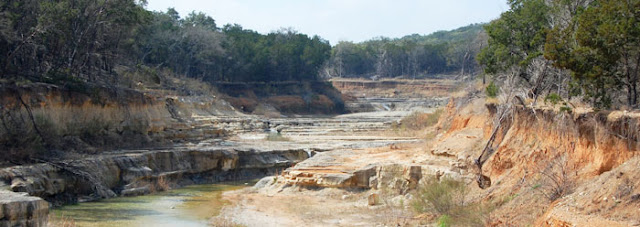 In 2002, Canyon Lake (man-made lake north of San Antonio, NW of New Braunfels) flooded after the watershed feeding the lake was subjected to 35 inches of rain in one week. The embankment dam has a wide emergency spillway that did its job and concentrated the overflow to a certain area of the embankment and its downstream target area. In just 3 days, the flood waters carved a canyon 1.5 miles long and up to 80 feet deep. The waters did not erode massive soil deposits, they cut through a limestone rock formation ! The geology in this area consists of materials of the Glen Rose geologic formation, that consists of inter-bedded limestone rock, marly limestone, nodular limestone, weak limestone, and rocky clay-marl. Although the marly materials are relativley erodible, the rock layers are not.
In 2002, Canyon Lake (man-made lake north of San Antonio, NW of New Braunfels) flooded after the watershed feeding the lake was subjected to 35 inches of rain in one week. The embankment dam has a wide emergency spillway that did its job and concentrated the overflow to a certain area of the embankment and its downstream target area. In just 3 days, the flood waters carved a canyon 1.5 miles long and up to 80 feet deep. The waters did not erode massive soil deposits, they cut through a limestone rock formation ! The geology in this area consists of materials of the Glen Rose geologic formation, that consists of inter-bedded limestone rock, marly limestone, nodular limestone, weak limestone, and rocky clay-marl. Although the marly materials are relativley erodible, the rock layers are not.Here is a photo during the flooding as it carved through a road crossing (South Access Road):
Someone considering only uniformitarian geology concepts might typically believe canyons and gorges are formed by rivers slowly eroding the landscape over "millions of years". The Canyon Lake gorge is one of many examples of empirical evidence that this is not the case. At the deepest cut this 3 day localized flood carved out up to 80 feet deep inter-bedded limestone materials. Are canyons formed by baseline flow river water over a long period of time, or a lot of flood water over a short period of time? Evidence before us indicates the latter actually occurs. The former is hypothesized and not empirical.
Here is another photo of the gorge carved in 3 days:
Here is one exposing faulting and also exposing boulder deposits (left):
Here is a close up of the boulder deposits that were placed during the 3 day flood event:
And here is another view of the eroded gorge.





No comments:
Post a Comment